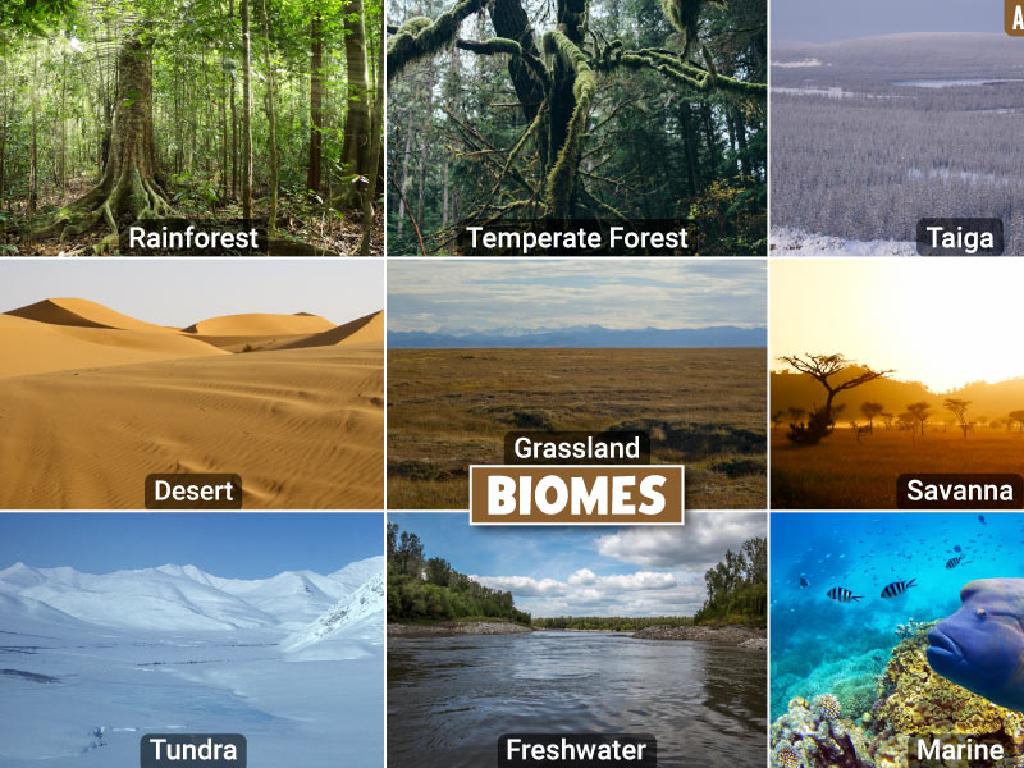Classify Rocks As Igneous, Sedimentary, Or Metamorphic
Subject: Science
Grade: Fifth grade
Topic: Rocks
Please LOG IN to download the presentation. Access is available to registered users only.
View More Content
Today’s Adventure: Classifying Rocks
– Explore three main rock types
– Igneous rocks: Earth’s fire-formed treasures
– Formed from cooled magma or lava, like granite
– Sedimentary rocks: Layers of history
– Made from compressed sediments, like sandstone
– Metamorphic rocks: Transformed by pressure
– Altered by heat and pressure, like marble
|
In this lesson, students will embark on a geological adventure to understand the classification of rocks. They will learn about igneous rocks, which are formed from the cooling and solidification of magma or lava. Examples include granite and basalt. Sedimentary rocks, like sandstone and limestone, are formed from the accumulation and compaction of sediment. Metamorphic rocks, such as marble and slate, are created when existing rocks are subjected to great heat and pressure. This lesson will highlight how each rock type provides clues about Earth’s history and the processes that have shaped our planet. Encourage students to bring in rock samples for discussion, if possible, and prepare a hands-on activity where they can examine and classify different rock types.
What Are Rocks?
– Rocks: Combinations of minerals
– Like a cookie with different chips, rocks have various minerals.
– Forming the Earth’s crust
– They make up the ground we walk on, the mountains we climb.
– Every rock tells a story
– Their formation and changes reveal Earth’s history.
|
Begin the lesson by explaining that rocks are not just random stones, but are made up of different minerals, much like ingredients in a recipe. Emphasize that the Earth’s crust, the outermost layer of our planet, is composed of these rocks. Discuss how each rock type has a unique formation process and history, which can include being erupted from volcanoes, formed from layers of sediment, or changed by heat and pressure. This will set the stage for understanding the classification of rocks into igneous, sedimentary, and metamorphic, based on their origin stories. Encourage students to think about the rocks they see in their daily lives and what stories those rocks might tell.
Classifying Rocks: Types and Formation
– Three main rock categories
– Igneous: Formed from cooling lava
– Examples: Basalt from lava, granite from magma
– Sedimentary: Made from layered particles
– Examples: Sandstone from sand, limestone from seashells
– Metamorphic: Changed by heat and pressure
– Examples: Slate from shale, marble from limestone
|
This slide introduces students to the three main categories of rocks and their formation processes. Igneous rocks form when molten rock (magma or lava) cools and solidifies. Sedimentary rocks are created from particles of sand, shells, pebbles, and other fragments of material. Over time, these particles accumulate in layers and are compressed into rock. Metamorphic rocks are formed under the surface of the earth from the change that occurs due to intense heat and pressure. Encourage students to bring rock samples if possible and discuss the characteristics that help us identify each type. Use the examples provided to help students connect the types of rocks with real-world examples they may have seen or collected.
Exploring Igneous Rocks
– Igneous rocks: formed from magma
– Magma cools and solidifies to form igneous rocks
– Common examples: Granite, Basalt
– Granite is often speckled, Basalt is usually dark and fine-grained
– Characteristics: Hard, interlocking crystals
– Look for very hard rocks with crystals that fit together like a jigsaw
– Identifying igneous rocks in nature
|
Igneous rocks are one of the three main types of rocks that students need to learn about. They are formed from the solidification of molten rock material called magma, which cools either beneath the Earth’s surface or upon it after a volcanic eruption. Examples like granite and basalt can be used to show the variety within igneous rocks. Granite, with its visible speckled crystals, and basalt, typically dark and fine-grained, serve as good representatives. When teaching, emphasize the characteristics of igneous rocks such as their hardness and the interlocking of crystals, which can be observed with a magnifying glass. Encourage students to bring in samples or provide them for an in-class hands-on activity to identify these rocks.
Exploring Sedimentary Rocks
– Formed from other rocks/materials
– Particles compacted over time, like sand or plant remains
– Examples: Sandstone, Limestone
– Sandstone from sand, Limestone from marine organisms
– Characteristics of sedimentary rocks
– Look for layers, fossils, and grainy texture
– Observing sedimentary rocks
|
Sedimentary rocks are a type of rock that forms from the accumulation and cementation of mineral and organic particles on the Earth’s surface, as well as within bodies of water. Common examples include sandstone, which is formed from compacted sand, and limestone, which is often composed of the skeletal fragments of marine organisms. When identifying sedimentary rocks, students should look for characteristics such as distinct layers, the presence of fossils, and a grainy texture. Encourage students to bring in samples or provide them with hands-on examples to observe these features closely. Discuss the process of sedimentation and the environments in which these rocks typically form, such as riverbeds, oceans, and lakes.
Metamorphic Rocks
– Formed by pressure and heat
– Intense conditions transform existing rock
– Examples: Marble, Slate
– Marble from limestone, Slate from shale
– Characteristics of metamorphic rocks
– Look for wavy layers and hard texture
– Role in Earth’s crust
|
Metamorphic rocks are a type of rock that have been changed by significant heat and pressure, altering their original structure. Common examples include marble, which originates from limestone, and slate, which comes from shale. Characteristics to identify these rocks include wavy or striped patterns, a hard texture, and a crystalline structure. These rocks play a crucial role in the composition of Earth’s crust and are important for students to recognize. Encourage students to touch and examine samples of metamorphic rocks to observe these features firsthand.
The Rock Cycle: Earth’s Rock Transformers
– Rocks change types over time
– Igneous to sedimentary to metamorphic and back
– Continuous rock formation process
– Heat, pressure, cooling, and erosion shape rocks
– Rock cycle examples in nature
– Mountains eroding, volcanoes erupting, sediment compressing
|
This slide introduces the concept of the rock cycle to the students, explaining how rocks undergo a transformation from one type to another over geological time. Emphasize that this process is continuous and natural, driven by Earth’s internal and external forces such as heat, pressure, cooling, and erosion. Provide vivid examples like the formation of mountains, volcanic eruptions, and the compression of sediment in bodies of water. Encourage students to think of the rock cycle as a ‘recycling’ process of our planet’s rocks. The goal is for students to understand that the rock types they are learning about are not static and can change into each other through various natural processes.
Classifying Rocks: Igneous, Sedimentary, Metamorphic
– Observe rock characteristics
– Look at color, texture, and grain size
– Use a rock classification chart
– Charts help identify rock types
– Classify your own rock samples
– Sort rocks into the three categories
– Record your observations
– Write down the features of each rock
|
This slide introduces students to the hands-on activity of classifying rocks. Begin by guiding students on how to observe and record the characteristics of rocks, such as color, texture, and grain size. Provide a classification chart to help them identify and categorize each rock as igneous, sedimentary, or metamorphic. During the hands-on activity, students will use their observation skills and the chart to classify provided rock samples. Encourage them to record their observations in detail. This activity will help solidify their understanding of the rock types and the classification process. Prepare a variety of rock samples for the activity and ensure each student or group has a classification chart and a worksheet for recording their findings.
Rock Detective Activity: Classifying Rocks
– Become a day geologist
– Examine rocks in groups
– Look at color, texture, and grain
– Classify each rock sample
– Is it igneous, sedimentary, or metamorphic?
– Share findings with class
– Discuss how you identified them
|
In this engaging class activity, students will step into the shoes of geologists and work together to examine various rock samples. Provide a diverse set of rocks for the students to observe and analyze. They should use their senses and any available tools to note the color, texture, and grain size, which are clues to the rock’s type. After examining the samples, each group will classify the rocks as igneous, sedimentary, or metamorphic and prepare a brief presentation to share their findings with the class. Encourage them to explain the reasoning behind their classifications. Possible activities include: matching rocks to descriptions, creating a rock classification chart, or drawing diagrams of the rock cycle with examples from their samples.
Rock Classification: Conclusion & Recap
– Review: Igneous, Sedimentary, Metamorphic
– Igneous form from cooled magma, sedimentary from compaction, metamorphic from heat/pressure
– Significance of classifying rocks
– Understanding Earth’s processes and history
– Exploring rocks beyond the classroom
– Collect rocks, use a magnifying glass, and visit nature centers
|
As we wrap up, let’s recall the three rock types: igneous, formed from cooled magma or lava; sedimentary, created from particles of other rocks or organic material that have been compacted; and metamorphic, which are altered by heat and pressure. Classifying rocks helps us understand the Earth’s processes and history. Encourage students to continue their geological journey by collecting rocks, examining them with a magnifying glass, and visiting local nature centers or museums. This hands-on approach will reinforce their learning and spark further curiosity about the natural world.





